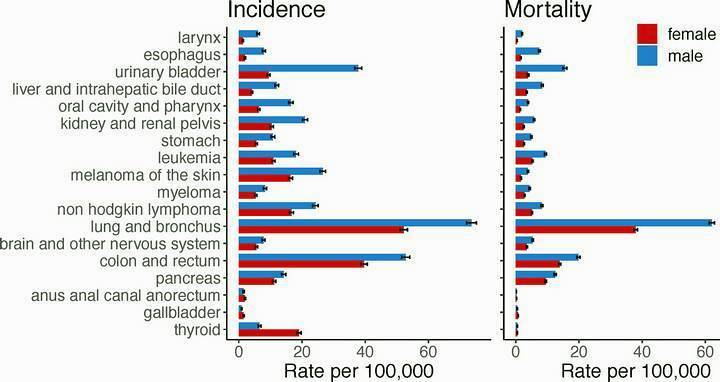 As the chart shows, men are more likely to suffer from and die from most cancers which are common to both sexes.
As the chart shows, men are more likely to suffer from and die from most cancers which are common to both sexes.
Skin cancer is clearly not unique in differing incidence rates, or outcomes. Melanoma is however one of the more pronounced and for other skin cancers, such as basal or squamous cell carcinoma, cases in men are higher.
Genetic and immune system factors partly account for the difference across many cancers, along with varying hormones men and women produce. For skin cancer, environmental exposure may create higher levels in men, along with physical differences.
Men have thicker skin with less fat underneath, their skin contains more collagen and elastin. Research has shown this makes men more susceptible to UV damage and that when damage does occur, women’s skin is better at self repair.
These aspects matter and could appear to be an entire rationale but data shows they are far from being the complete story.
Behavioural Influence
Considering the above, the reality for women aged between 16 and 50 seems out of line, as they are more likely to develop melanoma than men of the same age. The reason is greater use of sunbeds and longer sunbathing sessions.
Women are still less likely to see melanoma spread through their body, or the invasion prove fatal but the switch in incidence rate is striking. Not least as after they reach 65, men are far more likely than women to suffer from melanoma.
The places skin cancer appears adds weight to behavioral influences. In women, skin cancer on the legs is more common, for men, the torso is a leading area. Again, UV exposure takes the lead, rather than gender.
The use of sunscreen, or other skin protection measures is higher in women, although men who do regularly use sunscreen also see reduced skin cancer rates. The difference in adopting protective measures is mirrored in seeking medical assistance.
Men are less likely to see a doctor at an early stage, or to examine their own skin, or attend for professional skin screening.
A Rational Conclusion
There is little doubt that a more effective immune system and other genetic differences do give women an edge. Research across the globe has confirmed this but has also shown that the gap is not vast and can be levelled out.
There is a knowledge differential, so ensuring that men understand the reality of sun exposure and protection is important. Choices they make are still a core factor and unlike genetic differences, are within our control.
Debate on the extent that skin cancer rates vary due to gender behaviour, or biological differences will continue but the facts are evident. Sun protection lowers men’s risk of melanoma, skin exams reduce their risk of serious disease, or death.
That skin cancer treatment has advanced so much is welcome but is still better avoided, or reduced. If men see a specialist as soon as an issue is detected, or attend for regular skin checks, gender imbalance can be counteracted.
